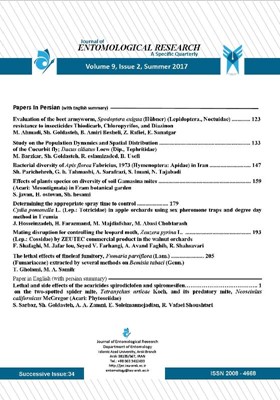-
-
List of Articles
-
Open Access Article
1 - Lethal and side effects of the acaricides spirodiclofen and spiromesifen on the two-spotted spider mite, Tetranychus urticae Koch, and its predatory mite, Neoseiulus californicus McGregor (Acari: Phytoseiidae)
S. Sarbaz Sh. Goldasteh A. A. Zamani E. Soleyman-Nejadian R. Vafaei -
Open Access Article
2 - Evaluation of the beet armyworm, Spodoptera exigua (Hübner) (Lep., Noctuidae) resistance to insecticides Thiodicarb, Chloropyrifos and Diazinon
M. Ahmadi Sh. Goldasteh B. Amiri Besheli Z. Rafiei E. Sanatgar -
Open Access Article
3 - Study on the population dynamics and spatial distribution of the cucurbit Fly; Dacus ciliatus Loew (Dip., Tephritidae)
M. Barzkar Sh. Goldasteh R. Eslamizadeh B. Usefi -
Open Access Article
4 - Bacterial diversity of Apis florea F. (Hym., Apidae) in Iran
Sh. Parichehreh G. H. Tahmasbi A. Sarafrazi S. Imani N. Tajabadi -
Open Access Article
5 - Effects of plant species on diversity of soil Gamasina mites (Acari: Mesostigmata) in Eram botanical garden
S. Javan H. Ostovan Sh. Hesami -
Open Access Article
6 - Determining the appropriate spray time to control Cydia pomonella L. (Lep., Totricidae) in apple orchards using sex pheromone traps and degree-day method in Urumia
J. Hosseinzadeh H. Farazmand M. Majdiafshar M. Abasi Chobtarash -
Open Access Article
7 - Mating disruption for controlling the leopard moth, Zeuzera pyrina L. (Lep.: Cossidae) by ZEUTEC commercial product in the walnut orchards
F. Shafaghi M. Jafar lou S. V. Farhangi A. Avand Faghih R. Shahsavari -
Open Access Article
8 - The lethal effects of fineleaf fumitory, Fumaria parviflora (Lam.) (Fumariaceae) extracted by several methods on Bemisia tabaci (Genn.)
T. Gholami M. A. Samih
-
The rights to this website are owned by the Raimag Press Management System.
Copyright © 2021-2025







